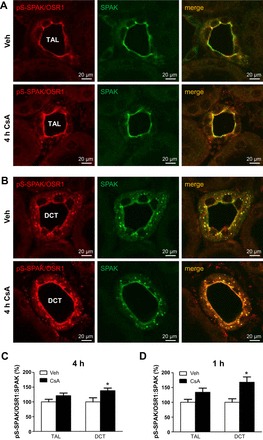Fig. 4.

Short-term (1- and 4-h) effects of cyclosporine A on apical abundance of phosphorylated Ste20-related proline/alanine-rich kinase (SPAK)/oxidative stress-responsive kinase 1 (OSR1) kinases as evaluated by confocal microscopy. A and B: representative images of kidney sections from vehicle- or cyclosporine A-treated rats (4 h) showing immunofluorescent labeling of phosphorylated regulatory SPAK/OSR1 domain [pS383/pS325 (pS-SPAK/OSR1)] and double labeling for SPAK in thick ascending limb (TAL, A) and distal convoluted tubule (DCT, B). TAL and DCT were identified according to morphological criteria and specific SPAK signal patterns (predominant apical signal in TAL vs. apical and punctate cytoplasmic signal in DCT). C: graphs showing pS-SPAK/OSR1-to-SPAK signal ratio in TAL and DCT of rats treated with vehicle or cyclosporine A for 4 h. D: graphs showing evaluation of pS-SPAK/OSR1-to-SPAK signal ratio in TAL and DCT of rats treated with vehicle or cyclosporine A for 1 h; respective immunofluorescent images are not shown. Data are means ± SE; *P < 0.05.
